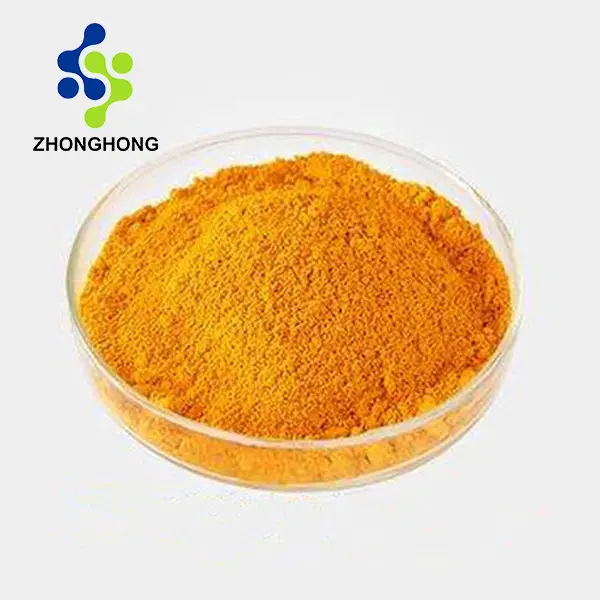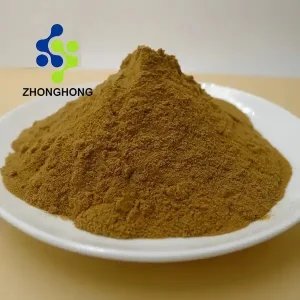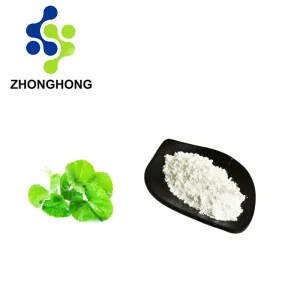Curcumin: The Golden Powerhouse from Nature
1. Introduction
In the dynamic landscape of the global health industry, Shaanxi Zhonghong Investment Technology Co., Ltd. shines as a preeminent raw material manufacturer and supplier. With a rich 28 – year legacy in the bioactive compound realm, our company has been unwaveringly committed to the research, development, production, and distribution of high – quality raw materials. Among our diverse product portfolio, Curcumin stands out as a remarkable offering, derived from the rhizomes of the turmeric plant (Curcuma longa). Our state – of – the – art facilities, partnerships with 5 top – tier universities, and possession of over 20 patented technologies enable us to provide unparalleled products and services. We have established a vast global network, catering to more than 80 countries across Asia, Europe, and the Americas, and offering customized raw material solutions to multinational pharmaceutical companies and research institutions.

2. Product Source and Chemistry
2.1 Source
2.2 Chemical Composition
3. Product Characteristics
- Appearance: Usually appears as a fine, bright yellow powder. The vibrant color is a key identifier of its quality and purity.
- Solubility: Curcumin has poor solubility in water, which is a challenge in some applications. However, it is soluble in organic solvents such as ethanol, methanol, and acetone. This property influences the choice of extraction methods and formulation strategies.
- Stability: It is relatively stable under normal storage conditions but can degrade when exposed to light, heat, and high humidity. Therefore, proper storage in air – tight, light – resistant containers is crucial to maintain its potency.
4. Product Specifications
- CAS: 458-37-7
- MF: C21H20O6
- MW: 368.38 g/mol
- EINECS: 207-280-5
| Project | Name | Indicator | Detection Method |
|---|---|---|---|
| Pesticide Residues | Chlorpyrifos | < 0.01 ppm | Gas Chromatography – Mass Spectrometry (GC – MS) |
| DDT | < 0.005 ppm | GC – MS | |
| Other common pesticides | Trace levels, typically < 0.01 ppm | GC – MS | |
| Heavy Metals | Lead (Pb) | < 0.1 ppm | Atomic Absorption Spectroscopy (AAS) |
| Mercury (Hg) | < 0.01 ppm | AAS | |
| Cadmium (Cd) | < 0.05 ppm | AAS | |
| Arsenic (As) | < 0.05 ppm | AAS | |
| Microbial Contamination | Total viable count | < 100 CFU/g | Standard microbiological plating techniques |
| Escherichia coli | Absent | Polymerase Chain Reaction (PCR) and plating | |
| Salmonella | Absent | PCR and plating | |
| Vibrio parahaemolyticus | Absent | PCR and plating | |
| Listeria monocytogenes | Absent | PCR and plating |
5. Extraction Methods
- Solvent Extraction: This is one of the most common methods. Turmeric powder is mixed with an organic solvent, such as ethanol or ethyl acetate. The mixture is then agitated for a specific period at a controlled temperature. The curcumin dissolves in the solvent, and after separation from the solid residue (by filtration or centrifugation), the solvent is evaporated to obtain a crude curcumin extract. Further purification steps, such as column chromatography, are often employed to increase the purity of the curcumin.
- Supercritical Fluid Extraction: Using supercritical carbon dioxide (scCO₂) as the extraction medium, this method offers several advantages. Supercritical CO₂ has properties similar to both liquids and gases, allowing it to penetrate the turmeric matrix effectively and selectively extract curcumin. The process is environmentally friendly as CO₂ is non – toxic, non – flammable, and easily removed from the extract. It also results in a purer product with less solvent residue compared to traditional solvent extraction.
6. Health Benefits and Mechanisms
6.1 Anti – Inflammatory Effects
- Mechanism: Curcumin inhibits multiple inflammatory pathways. It suppresses the activation of nuclear factor – kappa B (NF – κB), a transcription factor that plays a central role in the regulation of pro – inflammatory cytokines, such as tumor necrosis factor – alpha (TNF – α), interleukin – 1 beta (IL – 1β), and interleukin – 6 (IL – 6). By blocking NF – κB, curcumin reduces the production of these cytokines, thereby dampening the inflammatory response. This makes it potentially beneficial for conditions like arthritis, where chronic inflammation causes joint pain and damage.
6.2 Antioxidant Activity
- Mechanism: Curcumin acts as a powerful antioxidant by scavenging free radicals, such as superoxide anions, hydroxyl radicals, and peroxyl radicals. Its phenolic hydroxyl groups can donate hydrogen atoms to neutralize free radicals, preventing them from causing oxidative damage to cells. Oxidative stress, which is an imbalance between free radical production and the body’s antioxidant defenses, is associated with various chronic diseases, including cancer, cardiovascular diseases, and neurodegenerative disorders. Curcumin’s antioxidant properties help maintain the integrity of cells and tissues by reducing oxidative damage.
6.3 Antibacterial and Antifungal Effects
- Mechanism: Curcumin disrupts the cell membranes of bacteria and fungi. It can interact with the lipid components of the cell membranes, leading to increased membrane permeability and ultimately cell death. In addition, it may interfere with the synthesis of essential biomolecules in microorganisms, further inhibiting their growth and survival. This property makes curcumin useful in preventing and treating certain infections.
7. Physiological Efficacy for Different Groups
7.1 For Athletes
- Benefits: Helps in reducing post – exercise muscle inflammation and oxidative stress. Intense physical activity generates free radicals and triggers an inflammatory response in muscles. Curcumin can alleviate this inflammation, promoting faster muscle recovery and reducing muscle soreness. It also aids in improving exercise performance by enhancing the body’s antioxidant defense system, allowing athletes to train more effectively and reduce the risk of overtraining syndrome.
7.2 For the Elderly
- Benefits: May assist in managing age – related chronic diseases. As people age, the risk of developing conditions such as Alzheimer’s disease, cardiovascular diseases, and arthritis increases. Curcumin’s anti – inflammatory and antioxidant properties can help slow down the progression of these diseases. In the case of Alzheimer’s, curcumin may reduce the accumulation of amyloid – beta plaques, a hallmark of the disease, and improve cognitive function. For cardiovascular health, it can reduce oxidative stress in blood vessels, lower cholesterol levels, and improve blood vessel function.
7.3 For Individuals with Digestive Disorders
- Benefits: Can have a positive impact on inflammatory bowel diseases (IBD), such as Crohn’s disease and ulcerative colitis. By reducing inflammation in the gastrointestinal tract, curcumin can help alleviate symptoms like abdominal pain, diarrhea, and rectal bleeding. It may also promote the repair of the intestinal mucosa and modulate the gut microbiota, contributing to better digestive health. However, more research is needed to establish its full potential in treating these complex disorders.
8. Industrial Applications and Technological Innovations
8.1 Pharmaceutical Industry
- Applications: Curcumin is being investigated as a potential therapeutic agent for a wide range of diseases. Pharmaceutical companies are developing curcumin – based drugs for cancer treatment, where it may act as an adjuvant to enhance the efficacy of chemotherapy and radiotherapy. It is also being studied for its potential in treating neurodegenerative diseases, such as Alzheimer’s and Parkinson’s, due to its anti – inflammatory and antioxidant properties. In addition, curcumin – containing formulations are being developed for the management of metabolic disorders like diabetes and obesity.
8.2 Cosmetic Industry
- Applications: Incorporated into skincare products for its antioxidant and anti – inflammatory benefits. In anti – aging creams and serums, curcumin can help reduce the appearance of fine lines, wrinkles, and age spots by protecting the skin from oxidative damage caused by environmental factors such as UV rays and pollution. It also has a skin – brightening effect, making it useful in formulations for improving skin complexion. In hair care products, curcumin can strengthen hair follicles, reduce hair loss, and add shine.
8.3 Food Industry
- Applications: Used as a natural food colorant due to its bright yellow – orange color. It is also added to functional foods and beverages for its potential health benefits. For example, curcumin – fortified juices and smoothies are becoming popular as they offer both nutritional value and antioxidant properties. In addition, curcumin can act as a natural preservative in some food products, inhibiting the growth of spoilage – causing microorganisms.
9. Research Frontiers and Challenges
9.1 Research Frontiers
- Drug Delivery Systems: Scientists are actively researching new drug delivery systems to improve the bioavailability of curcumin. Nano – encapsulation techniques, such as liposomes, nanoparticles, and micelles, are being explored. These delivery systems can protect curcumin from degradation in the gastrointestinal tract, enhance its solubility, and improve its absorption and targeting to specific tissues or cells.
- Combination Therapies: There is a growing interest in developing combination therapies using curcumin. Combining curcumin with other drugs or bioactive compounds may lead to synergistic effects, enhancing the overall therapeutic outcome. For example, combining curcumin with chemotherapeutic agents in cancer treatment may increase the sensitivity of cancer cells to chemotherapy and reduce the side effects of the drugs.
9.2 Challenges
- Low Bioavailability: One of the major challenges with curcumin is its poor bioavailability. Due to its low solubility in water, rapid metabolism, and limited absorption in the gastrointestinal tract, only a small amount of orally administered curcumin reaches the systemic circulation. Developing strategies to improve its bioavailability, such as using absorption enhancers or novel drug delivery systems, is a key area of research.
- Standardization: There is a lack of standardized extraction and quality control methods across the industry. Different extraction methods and sources of turmeric can result in products with varying curcumin content and purity. Establishing uniform standards for extraction, purity, and potency is essential for ensuring the consistency and reliability of curcumin – containing products in the market.
10. Production Process
- Harvesting: Turmeric rhizomes are carefully harvested when the plants reach maturity, usually after 8 – 10 months of growth. The rhizomes are dug out of the soil and washed thoroughly to remove dirt and impurities.
- Drying: The washed rhizomes are then dried, either in the sun or using mechanical dryers. Drying reduces the moisture content of the rhizomes, making them easier to store and process.
- Milling: The dried rhizomes are milled into a fine powder. This powder is the starting material for the extraction process.
- Extraction: As described earlier, either solvent extraction or supercritical fluid extraction is carried out. The choice of extraction method depends on factors such as cost, desired purity, and environmental considerations.
- Purification: The crude curcumin extract undergoes multiple purification steps. Column chromatography is commonly used to separate curcumin from other components in the extract, such as other curcuminoids, resins, and waxes. This results in a highly pure curcumin product.
- Drying and Packaging: The purified curcumin is dried to a powder form and then packaged in air – tight, light – resistant containers. The packaging materials are selected to protect the product from moisture, light, and oxygen, ensuring its stability and quality during storage and transportation.
11. Quality Control
12. Usage Tutorial
12.1 In Pharmaceutical Formulations
- Oral Supplements: For oral consumption, curcumin is often formulated into capsules, tablets, or soft gels. The recommended dosage can vary depending on the intended use and individual health conditions. In general, for general health maintenance, a daily dose of 500 – 1000 mg is commonly suggested. However, for specific therapeutic applications, such as in cancer treatment or managing inflammatory diseases, higher doses under the supervision of a healthcare professional may be prescribed. It is important to take curcumin with food to enhance its absorption.
- Topical Applications: In topical creams, ointments, or gels, curcumin is used at concentrations ranging from 0.5% – 2%. These products are applied directly to the skin for treating skin conditions such as acne, psoriasis, or to improve skin appearance. Gently massage the product into the affected area until fully absorbed.
12.2 In Cosmetic Formulations
- Skincare Products: When using curcumin – containing skincare products, apply them to clean, dry skin. For face creams, take a small amount and spread it evenly over the face and neck, using upward and outward motions. For body lotions, apply as you would with regular body lotions, focusing on areas that need hydration and antioxidant protection.
- Hair Care Products: In hair care products like shampoos and conditioners, curcumin can help strengthen hair and reduce hair loss. Use these products as you would with your regular hair care routine, massaging the shampoo into the scalp and rinsing thoroughly, followed by applying the conditioner.
13. Packaging, Shipping, and Samples
13.1 Packaging
13.2 Shipping
13.3 Samples
14. After-sales service
15. General Information, Qualifications, and Certifications
- Company Name: Shaanxi Zhonghong Investment Technology Co., Ltd.
- Years of Experience: 28 years in the bioactive compound industry.
- Certifications: We hold a range of international certifications, including ISO 9001 for quality management, GMP (Good Manufacturing Practice) for pharmaceutical – grade production, and Kosher and Halal certifications. These certifications attest to our commitment to quality, safety, and compliance in the production and distribution of curcumin.
16. FAQ
- Q: Is curcumin safe for long – term use?
- A: In general, curcumin has a good safety profile. However, long – term use should be under the supervision of a healthcare professional, especially for individuals with pre – existing medical conditions or those taking other medications. High doses of curcumin may cause mild gastrointestinal discomfort in some people.
- Q: Can curcumin interact with other medications?
- A: Yes, curcumin can interact with certain medications. For example, it may enhance the effects of anticoagulant or anti – platelet medications, increasing the risk of bleeding. It can also interact with drugs metabolized by the liver’s cytochrome P450 enzyme system. It is important to inform your doctor if you are taking any prescription drugs before starting curcumin supplements.
17. References
- Aggarwal, B. B., & Harikumar, K. B. (2009). Potential therapeutic effects of curcumin, the anti – inflammatory agent, against neurodegenerative, cardiovascular, pulmonary, metabolic, autoimmune and neoplastic diseases. International Journal of Biochemistry & Cell Biology, 41(1), 40 –






aence*** –
Technical details strengthen trust: “aiherba uses supercritical extraction for our customized curcumin, and the color and smell are purer than traditional methods. The technical team explained that their low-temperature process avoids the destruction of heat-sensitive ingredients, and end consumers reported that ‘it is absorbed faster on the face’, which has become the main selling point of our product page.”
Stormy –
Admiring the commitment you put into your site and in depth information you offer.
It’s nice to come across a blog every once in a
while that isn’t the same out of date rehashed information. Excellent read!
I’ve bookmarked your site and I’m adding your RSS feeds to my Google account.
Here is my web page increase tweet views
Jeanette –
I enjoy what you guys are usually up too. This sort of clever work and reporting!
Keep up the superb works guys I’ve incorporated you guys to blogroll.
Here is my page … real tiktok views